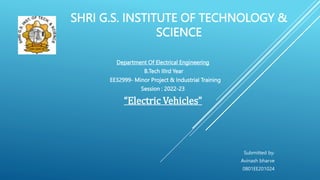
EV.pptx
- 1. SHRI G.S. INSTITUTE OF TECHNOLOGY & SCIENCE Department Of Electrical Engineering B.Tech IIIrd Year EE32999- Minor Project & Industrial Training Session : 2022-23 “Electric Vehicles” Submitted by: Avinash bharve 0801EE201024
- 2. CONTENT Introduction Working Advantages Disadvantage Types of EV Conclusion Referance
- 3. INTRODUCTION An electric vehicle (EV) is a vehicle that uses one or more electric motors for propulsion. EVs first came into existence in the mid-19th century, when in 1828 an inventor Anyos Jedlik invented an electric motor by which he was able to use his motor to create a small electric car. The first mass-produced electric vehicles appeared in America in the early 1900s. However, with the production of cheap assembly line cars by Ford Motor Company, the popularity of electric cars declined significantly. Also due to the limitations of storage batteries at that time, the wide availability of affordable made internal combustion powered cars cheaper to operate over long distances. Also, internal combustion powered cars became ever-easier to operate due to the invention of the electric starter in 1912 and the noise emitted by ICE cars became much more reduced due to the use of the muffler, invented in 1897. Finally, the initiation of mass production of petrol powered vehicles by Henry Ford in 1913 reduced significantly the petrol cars as compared to electric cars. petrol electric cars did not gain much popularity
- 4. WORKING Electric cars function by plugging into a charge point and taking electricity from the grid. They store the electricity in rechargeable batteries that power an electric motor, which turns the wheels. When the accelerator pedal is pressed it sends a signal to the controller which is like the brain of a vehicle, managing all of its parameters. Power is converted from the DC battery to AC for the electric motor using an inverter. The electric motor draws power from the battery to drive the car’s wheels and enable propulsion. Most electric cars will use lithium-ion batteries as they can store a lot more energy. In electric cars batteries are usually found positioned low down in the car, this helps to regulate the car’s centre of gravity. Electric motor converts electrical energy into mechanical energy (rotation). Rotation of the motor rotor rotates the transmission so the wheels turn and then the car moves.
- 5. ADVANTAGES Reduced noise Less maintenance required due to fewer moving parts Environment friendly and reduced emissions Instant power delivery
- 6. DISADVANTAGES Vehicles are priced higher Not enough charging stations available Recharging takes longer time Limited amount of range
- 7. TYPES OF ELECTRIC VEHICLES BATTERY ELECTRIC VEHICLE (BEV) HYBRID ELECTRIC VEHICLE (HEV) FUEL CELL ELECTRIC VEHICLE (FCEV)
- 8. BATTERY ELECTRIC VEHICLE (BEV) A Battery Electric Vehicle (BEV), also called All-Electric Vehicle (AEV), runs entirely on a battery and electric drive train. This types of electric cars do not have an ICE. Electricity is stored in a large battery pack that is charged by plugging into the electricity grid. The battery pack, in turn, provides power to one or more electric motors to run the electric car. Intially the power is converted from the DC battery to AC for the electric motor. The accelerator pedal sends a signal to the controller which adjusts the vehicle’s speed by changing the frequency of the AC power from the inverter to the motor. The motor connects and turns the wheels. When the brakes are pressed or the electric car is decelerating, the motor becomes an alternator and produces power, which is sent back to the battery
- 9. Examples Tesla Model 3, BMW i3, Nissan LEAF , Ford Focus Electric, Tesla X.
- 10. HYBRID ELECTRIC VEHICLE (HEV) This type of hybrid cars is often called as standard hybrid or paralel hybrid. HEV has both an ICE and an electric motor. In this types of electric cars, internal combustion engine gets energy from fuel (petrol and others type of fuels), while the motor gets electricity from batteries. The petrol engine and electric motor simultaneously rotate the transmission, which drives the wheels. The difference between HEV compared to other type of electric vehicles is where the batteries in HEV can only charged by the ICE, the motion of the wheels or a combination of both. There is no charging port, so that the battery cannot be recharged from outside of the system, for example from the electricity grid.
- 11. Examples Honda Civic Hybrid, Toyota Prius Hybrid, Honda Civic Hybrid, Toyota Camry Hybrid.
- 12. FUEL CELL ELECTRIC VEHICLE (FCEVS) Fuel Cell Electric Vehicles (FCEVs), also known as fuel cell vehicles (FCVs) or Zero Emission Vehicle, are types of electric cars that employ ‘fuel cell technology’ to generate the electricity required to run the vehicle. In this type of vehicles, the chemical energy of the fuel is converted directly into electric energy. The working principle of a ‘fuel cell’ electric car is different compared to that of a ‘plug-in’ electric car. This types of electric cars is because it generates the electricity required to run this vehicle on the vehicle itself
- 13. Examples Toyota Mirai, Hyundai Tucson FCEV,, Honda Clarity Fuel Cell, Hyundai Nexo.
- 14. CONCLUSION The progress that the electric vehicle industry has seen in recent years is not only extremely welcomed, but highly necessary in light of the increasing global greenhouse gas levels. As demonstrated within the economic, social, and environmental analysis sections of this webpage, the benefits of electric vehicles far surpass the costs. The biggest obstacle to the widespread adoption of electric-powered transportation is cost related, as gasoline and the vehicles that run on it are readily available, convenient, and less costly. As is demonstrated in our timeline, we hope that over the course of the next decade technological advancements and policy changes will help ease the transition from traditional fuel-powered vehicles
- 15. REFERENCE https://scholarworks.lib.csusb.edu/ https://www.researchgate.net/ https://www.sciencedirect.com/
- 16. THANK YOU Teri ma ki chut, bsdk, teri gand me land mera , bag bosdike